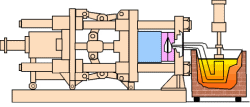The zinc die casting process is a widely used manufacturing technique that allows manufacturers to produce intricately shaped and high-quality metal parts. This process involves melting zinc alloy and injecting it into a mold under high pressure. Once the molten zinc solidifies, the mold is opened, and the final product is ejected. Zinc Die Casting Process
Here are the key steps involved in the zinc die casting process:
1. Mold Preparation: The first step in the process is to prepare the mold. The mold is typically made from steel and consists of two halves, the cavity and the core. These halves are designed to create the desired shape of the finished part.
2. Melting the Zinc Alloy: The next step is to melt the zinc alloy. The zinc is heated to its melting point, which typically ranges from 380 to 480 degrees Celsius, depending on the specific alloy being used. Once molten, the zinc is maintained at a controlled temperature to ensure consistency in the casting process.
3. Injection: With the mold prepared and the zinc alloy molten, the injection phase begins. The molten zinc is forcibly injected into the mold cavity under high pressure. The high pressure helps the molten metal fill all the intricate details of the mold design accurately.
4. Solidification: After the injected metal fills the mold, it rapidly cools and solidifies. The cooling time depends on the size and complexity of the part being cast. Uniform cooling is essential to ensure consistent mechanical properties in the finished product.
5. Mold Opening and Part Ejection: Once the metal has solidified, the mold is opened, and the part is ejected. Ejector pins or other mechanisms are used to facilitate the safe removal of the finished part from the mold.
6. Trimming and Finishing: After the part is ejected, any excess material or flash is removed by trimming. It may be necessary to perform additional finishing operations, such as deburring or polishing, to achieve the desired surface finish and quality.
7. Inspection and Quality Control: The final step in the zinc die casting process involves inspecting the finished parts for dimensional accuracy, surface defects, and other quality parameters. Thorough quality control measures help ensure that only parts meeting the specified standards are released for further use or assembly.
Advantages of Zinc Die Casting:
– High detail and dimensional accuracy: The zinc die casting process allows for the production of highly detailed and accurately shaped parts.
– Excellent strength and durability: Zinc alloys offer excellent strength and durability, making them suitable for various applications.
– Cost-effective: The relatively low melting point of zinc alloys and the high-speed production capabilities of die casting make it a cost-effective manufacturing process.
– Wide range of finishes: Zinc die cast parts can be finished with various surface treatments, including plating, painting, and powder coating, to enhance their appearance and provide corrosion resistance.
At Die Casting Zinc Company, the zinc die casting process provides manufacturers with a reliable and efficient method for producing complex and high-quality metal parts. With its cost-effectiveness and versatility, it has become a popular choice across various industries, including automotive, electronics, and consumer goods.
Zinc Die Casting Company makes metal parts for several industries. To get metal parts prices or prices for zinc die castings, or Email us at Sales@DieCastingZinc.com for die casting part prices or Zinc Die Casting Tooling Prices.
Permalink: https://www.diecastingzinc.com/zinc/positives-of-zinc-die-casting/


